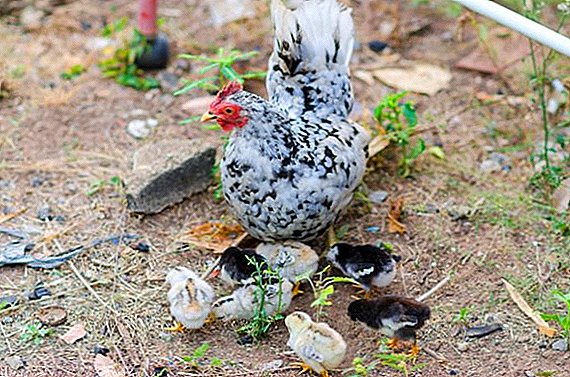 Engaging in breeding chickens is one of the ideas that often visits summer residents and people living in the private sector. The advantages of this occupation are obvious: it is an opportunity to get high-quality dietary meat and eggs, as well as excellent organic fertilizer (litter). In addition, breeding such a bird is quite simple and even a beginner, far from farming. The only thing that needs to be done first of all, except for the purchase of the bird itself, is to arrange for it a warm, comfortable home. Today we will tell you how to build a chicken coop on your own to keep 20 chickens, while spending a minimum of money, but having an excellent result.
Engaging in breeding chickens is one of the ideas that often visits summer residents and people living in the private sector. The advantages of this occupation are obvious: it is an opportunity to get high-quality dietary meat and eggs, as well as excellent organic fertilizer (litter). In addition, breeding such a bird is quite simple and even a beginner, far from farming. The only thing that needs to be done first of all, except for the purchase of the bird itself, is to arrange for it a warm, comfortable home. Today we will tell you how to build a chicken coop on your own to keep 20 chickens, while spending a minimum of money, but having an excellent result.
Choosing the type of chicken coop
First of all, it is necessary to determine the type of house, it can be with a vestibule or with a spacious walking yard. To understand which one of them is necessary for you, let's take a closer look at the specifics of such buildings.
It will be useful for you to learn about the features of choosing a chicken coop when buying.
Coop with a vestibule
Such a house is necessary in those cases where it is assumed year-round chicken.
A small waiting room will act as protection against severe frosts and help to preserve heat inside the building. 
Chicken Coop
A building with a walking yard is an excellent option for those who are going to keep chickens in the summer and do not want to bother with the organization of bird walks.
Did you know? Lack of daylight, low temperature, poor feed, illness, stress, lack of water and heat can interrupt the process of laying eggs.
After all, when free-range, they not only can create a mess in the yard, but also eat something unnecessary, which would entail all sorts of trouble.
Keeping them locked up in a warm season looks like a real blasphemy, so a henhouse with a fenced net, a spacious free-standing courtyard is an excellent option. 
Selection of foundation type
Of great importance is the fact that will keep the building. Therefore, to determine the type of foundation is also necessary immediately.
You need to choose from 3 options, each of which has its own advantages and disadvantages.
Did you know? If you do not plan for the chickens to bring offspring, and are ready to be content with meat and eggs, then the rooster in the house is not needed.
Strip foundation
If you want the building to be very strong and reliable and serve as a bird's house for many years, then the strip foundation meets these requirements by 100%.
But be prepared for the fact that over the laying of such a framework will have to work hard, namely:
- Draw the markup.
- Dig trenches.
- Fill up and tamp the trench with sand.
- To build the formwork of the boards and the frame of the reinforcement.
- Pour the concrete and let it dry for at least 4 days.
- Line the roofing felt and install the frame of the timber.
 The disadvantages of such a foundation also include the high cost, which is not always acceptable for farm buildings.
The disadvantages of such a foundation also include the high cost, which is not always acceptable for farm buildings.Important! In those cases when there is a loose soil at the site and there is a probability of it being washed with water, preference should be given to the strip foundation.
Pillar foundation
This is the most budget version of the house. Another advantage is the simplicity of the structure, which is also often of great importance, especially for people who have never dealt with the construction.
It is enough to bury supports in the ground, for example, 4 concrete blocks, and lay a space between them with bricks. From above, as well as when laying the strip foundation, it is recommended to lay the roofing felt, and then the frame of the beam.
The disadvantages of such a framework include low reliability and fragility. 
Pile foundation
Slightly more expensive than the columnar, but cheaper than the tape, will cost pile foundation. Such a foundation can also be laid in one's own hands, but by no means independently; at least one more assistant will be required. To lay this foundation, it is necessary to choose screw piles, which, in the presence of a partner, can be simply installed in the ground.
This type of foundation is considered strong and reliable. The disadvantage of such a framework is only that it will cost more than a columnar one. 
Material selection
Depending on financial possibilities, climatic conditions, as well as your own preferences, you can use different materials for the construction of the house, let's consider which ones.
Foam blocks
Foam blocks are considered to be a versatile building material, they are suitable both for regions with a very harsh climate, and for those places where the climate is temperate.
Using them, you can be absolutely sure that the dampness, drafts and coldness of the chickens will not be disturbed.  But the chicken coop, built of foam blocks, will cost a pretty penny, as the material is expensive.
But the chicken coop, built of foam blocks, will cost a pretty penny, as the material is expensive.
Did you know? The younger the hen, the larger the eggs laid by her and the larger the yolk in the middle.
Shellfish
It is simple to work with a shell rock, it retains heat well and at the same time is relatively inexpensive, especially in comparison with foam blocks and bricks.
But when choosing this material, you should definitely take into account that if you do not take care of the interior and exterior decoration, the birds living in such a house can start pecking at the walls, since the shell rock has to their taste. 
Tree
Wood can be considered the golden mean when choosing material for the chicken coop. Its advantages include accessibility and ease of operation.
If the wood is properly processed, the house will last for a long time.
The disadvantage is that for the winter housing of chickens the house will need to be well warmed, since the wood does not keep heat very well.
Brick
If you plan to build a durable house, the brick is the best option. Such a house will serve for decades, and besides, it is very easy to build. The disadvantages of bricks include only the high cost.
Slag stones
Slag blocks keep heat poorly, so they are best suited for buildings in temperate regions. But it should be borne in mind that in any case, we need the insulation of the structure. 
The choice of insulation
The health of the birds depends on how warm it will be in the chicken coop in winter, and therefore, how well they will be carried. Therefore, it is recommended to warm the building in order to guarantee a comfortable living of the hens. This can be done using the following materials.
Find out what are the features of laying hens, as well as how to make a nest, roost and feed for laying hens.
Styrofoam
Universal and affordable material that is suitable for wall insulation in any hen house. Polyfoam provides reliable protection from wind and draft, and also perfectly keeps warm air indoors. But after carrying out insulation works, it is recommended to take care of the finishing, since chickens can regard the foam as a treat and peck at it.
Mineral wool
For wooden buildings most often used mineral wool. This material is available and at the same time has excellent performance. By laying mineral wool between the inside and outside of the finish, warmth and lack of drafts in the chicken coop will be provided.
Hay
The most affordable insulation, at first glance, is hay. But it is worth considering that before use it must be treated from parasites.
It will also be necessary to mix this natural material with cement at a ratio of 1:10 in order that it not only retains heat, but also is durable. 
Building
We figured out what type a house and its foundation can be, as well as what materials can be used to build and warm it.
We now turn to the practical part - drawing schemes, laying the foundation and walls, as well as to the insulation.
We recommend that you familiarize yourself with the decorative, fighting, meat, egg and egg breeds of chickens.
Video: how to build a chicken coop with your own hands
Definition with size
In order for the conditions for the birds to be as comfortable as possible, it should be borne in mind that 2 chickens need 1 square meter. m of space, plus, should take into account the presence of drinking bowls, feeders and other equipment, which also need a place.
This means that for living 20 individuals will need a house, whose area is 15-20 square meters. The ceiling height in the hen house can vary from 170 cm to 2 m.
Before proceeding with construction, it is imperative to draw a drawing in which the dimensions of the building will be indicated in 3 projections. An example you can see below.
Important! A well-designed construction plan will help to correctly calculate the necessary materials and facilitate the construction of the chicken coop.
Base and walls
The most popular type of foundation is considered to be columnar, it refers to the budget, and for its construction does not need special knowledge and skills.
In order to make such a framework, it is necessary:
- Measure the place chosen for future construction, and mark the corners of the house with 4 pegs, and then connect them with a rope. Thus, we denote the perimeter of the structure.
- Remove 25-35 cm of soil.
- Every 1.5-2 m to dig holes 0.5 m deep.
- Install or erect pits in the pits, which should protrude at least 20 cm above the soil level.
- Next you need to make a harness, as well as lay logs.
- Lags, which can be used as a bar, cover with roofing material in 2 layers.
- Free space, that is, the emptiness between the pillars and the soil, as well as the inner perimeter is covered with rubble.
After the foundation is laid, we proceed to the construction of the frame.
It is a frame construction that will be the best option for building your own on a column base.
At this stage it is necessary:
- Using timber, build a frame for the house according to the drawn pattern.
- To support you need to nail the rack, which should be placed vertically.
- Horizontally nail the crossbar to the floor and roof structures.
- Once the frame is ready, it is completely sewn with wood outside.
Video: do-it-yourself chicken house construction
Important! It is necessary to provide for the presence of several windows and a door.
Wall insulation
For winter use of the house it is necessary to warm it. We have already said that you can use foam plastic, mineral wool or hay.
Let's take a look at how to make a house for chickens warm using foam:
- The inside of the house should be sheathed with sheets of foam.
- Top insulation sew up with boards, plywood or plastic.
Floor insulation
It is believed that this stage can be avoided and cover the floor in the house for the winter with a thick bed of straw, hay or sawdust. But stationary insulation is much more convenient and hygienic, especially since the process does not take much time and effort. In order to do this, you will need:
- Lay on the frame of the insulation boards (foam, mineral wool or a mixture of hay and concrete).
- Cover the floor with boards.
- Carry out wood processing on the floor with linseed oil.
Video: how to insulate the chicken coop
The importance of ventilation in the winter hen house
Chickens constantly need fresh air, so do not forget about such an important moment as air vents. Ventilation pipes are installed at the two ends of the building. One hole should be located at the ceiling, and the other - in front of him at 0.5 m below.
Dampers should be provided for these holes, with the help of which air can be regulated in the house.
Read more about the importance and types of ventilation in the chicken coop.
Interior finish
Now it is necessary to equip the chicken coop with everything necessary for comfortable living of birds, as well as ease of caring for them.
Perches
First you need to decide on the place where the bird's perch will be located. Then you need to make measurements, according to which and pick a bar for a perch.
It is worth considering that the best space on the perch for one hen is 30 cm, respectively, for 20 birds you need to equip 2 perches, the total length of which will be at least 6 meters.
Two beams, which will serve as a roost for layers, shall be attached at least 30 cm apart. 
Nests
Nests can be open or closed, it is considered to be that in closed space, the hens feel more protected.
Nests measuring 40 * 30 cm are made of boards or plywood. Inside, they must be lined with sawdust or straw. 20 layers need to equip 5 nests.
Did you know? Laying eggs lay only in the presence of light, and it does not matter whether it is daylight or artificial.
Drinking bowl
Water for birds should be in a convenient and accessible place, but preferably just above the floor. Drinkers can be of different types, namely: ordinary, bell-shaped and nipple. The latter are the most hygienic, as they do not get garbage.
Manger
Food should also be in an accessible and convenient place. It is important that the feeders have high sides, this will help avoid spilling the food. 
Lighting
Light is needed to make a winter coop. The lighting will be used from mid-autumn to early spring in order to prolong the daylight hours for the hens.
For a small chicken coop will be enough one light bulb, which you need to certainly cover the canopy.
Read also what vitamins to give chickens to increase egg production.
Now you know that building a winter house for 20 layers is quite simple. The financial cost of building depends on your abilities and preferences, and can be both minimal and high.












